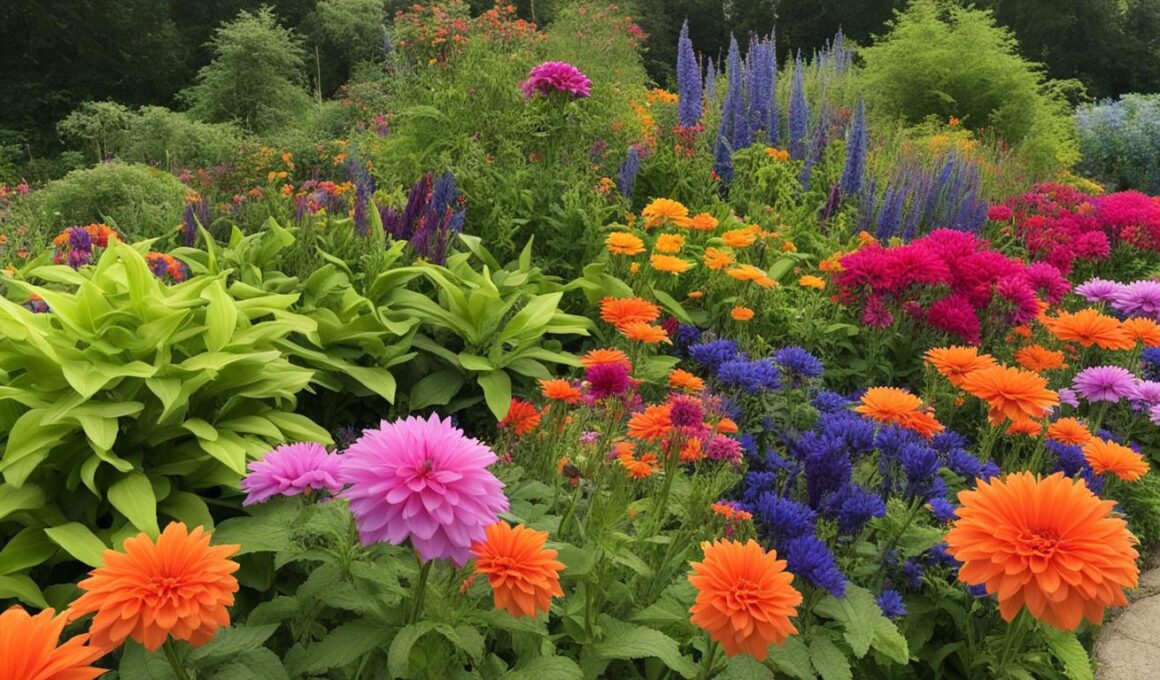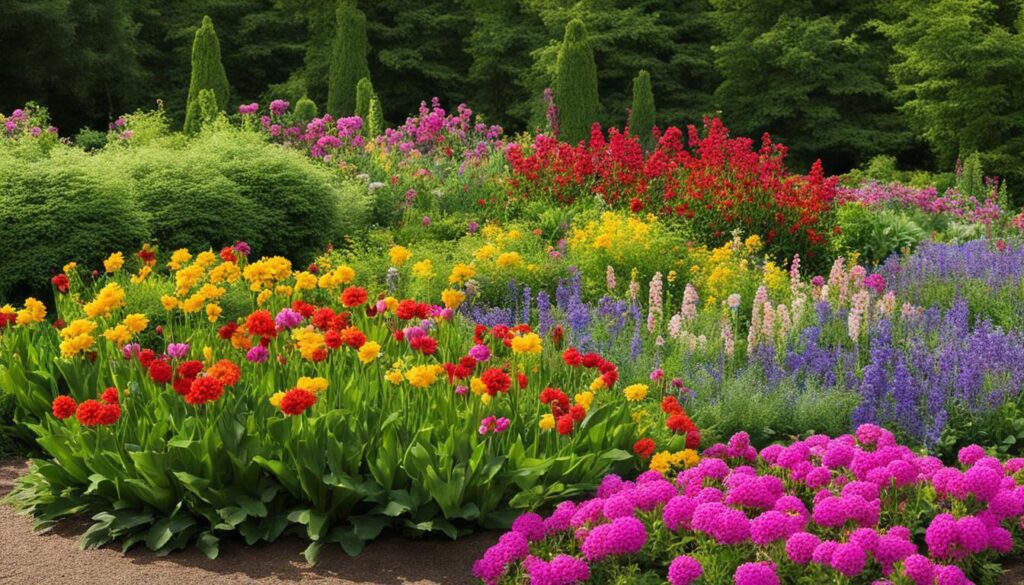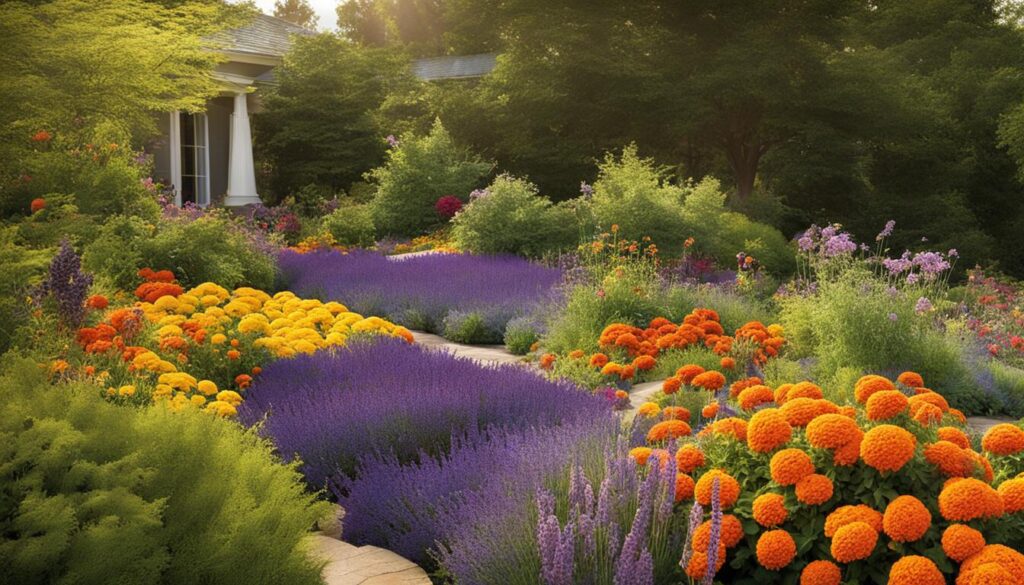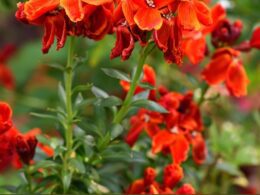If you’re allergic to bee stings or have a fear of insects, you may want to create a bee-free garden by planting flowers that don’t attract bees. Bees are attracted to flowers based on factors such as color, smell, nectar, pollen, and flower shape. By understanding these factors, you can choose the right flowers to keep bees away from your garden.
Key Takeaways:
- Choosing flowers that bees don’t like can help create a bee-free garden.
- Bees are attracted to flowers based on factors like color, smell, and nectar.
- Flowers that repel bees include geraniums, marigolds, and red lilies.
- Other plants like basil and rosemary can also deter bees.
- Create a picturesque, bee-free garden by selecting the right flowers and plants.
Why Don’t Some Flowers Attract Bees?
Have you ever wondered why certain flowers seem to be ignored by bees? There are several reasons why some flowers don’t attract bees, and understanding these reasons can help you create a bee-free garden.
One of the factors that influence a flower’s attractiveness to bees is its color. Bees are most attracted to colors with shorter wavelengths, such as purple, violet, and blue. These colors appear vibrant and attractive to bees. On the other hand, flowers with red hues are less appealing to bees because to them, red appears as black. So, if you want to discourage bees from visiting your garden, consider planting flowers with colors that bees find less appealing.
The scent of a flower is another important factor. Bees are attracted to flowers with pleasant smells, while flowers with unpleasing smells are avoided. Flowers like Mexican marigolds, chrysanthemums, and cinnamon tend to have scents that repel bees. By choosing flowers with scents that bees don’t prefer, you can reduce bee activity in your garden.
Another reason some flowers don’t attract bees is their lack of nectar and pollen or their flower shape. Bees are naturally drawn to flowers that provide them with ample nectar and pollen as a food source. Flowers that have limited nectar and pollen stores are less attractive to bees. Additionally, flowers with complex or inaccessible flower shapes make it difficult for bees to access the nectar and pollen, reducing their appeal to these pollinators.
Understanding why certain flowers don’t attract bees can help you choose the right flowers for your bee-free garden. By opting for flowers with colors that bees find less appealing, choosing varieties with scents that repel bees, and selecting flowers with accessible nectar and pollen stores, you can create a garden that is less likely to attract bees. In the next section, we will explore specific flowers that don’t attract bees, providing you with options to consider for your bee-free garden.
Flowers That Don’t Attract Bees
In your quest to create a bee-free garden, there are several flowers that you can rely on to repel bees. These flowers not only add beauty to your garden but also help keep those buzzing insects away. Geraniums, marigolds, red lilies, cardinal flowers, red hot poker, and tulips are examples of flowers that don’t attract bees.
Geraniums emit an unpleasant odor that bees find off-putting, making them an excellent choice for a bee-free garden. Marigolds, with their pungent scent and double petals, make it difficult for bees to access nectar and pollen. Red lilies have petals that create a barrier for bees to collect nectar and pollen. Meanwhile, cardinal flowers and red hot poker have tubular shapes that are not easily accessible for bees, further deterring them. Even though tulips are generally attractive to bees, they have limited nectars and their close flower heads make it challenging for bees to access the nectar.
By incorporating these bee-repellent flowers into your garden, you can enjoy a beautiful and bee-free outdoor space. Their natural abilities to repel bees effectively help create a peaceful environment for those who are allergic or simply prefer to keep bees at a distance.
Bee-Repellent Plants for a Bee-Free Garden
Creating a bee-free garden is not only about selecting flowers that don’t attract bees, but also incorporating other plants that can help repel them. These plants have scents that bees find deterrence. By strategically placing these bee-repellent plants in your garden, you can keep bees away and enjoy a bee-free environment.
One of the plants that can repel bees is basil. While bees may be attracted to basil when it’s in bloom, they are not drawn to it when it’s not flowering. The distinct scent of basil acts as a deterrent for bees, making it an ideal addition to your bee-free garden.
Citronella is another plant that is well-known for repelling mosquitoes, but it can also help deter bees. The strong aroma of citronella is disliked by bees, making it an effective insect-repellent plant. By planting citronella in your garden, you can create a space that is less appealing to bees.
Wormwood is a plant that emits a pungent scent that repels bees. Its strong aroma is often used to keep pests at bay, including bees. By including wormwood in your garden, you can create a barrier that bees are unlikely to cross.
Lastly, rosemary is a herb that has a strong scent that is off-putting to many insects, including bees. By planting rosemary in your garden, you can deter bees while enjoying the aromatic fragrance of this versatile herb. Rosemary not only repels bees but also adds flavor to your culinary dishes.
Summary:
- Basil, when not in bloom, can repel bees with its distinct scent.
- Citronella, known for repelling mosquitoes, can also deter bees with its strong aroma.
- Wormwood emits a pungent scent that repels bees, making it an effective deterrent.
- Rosemary has a strong scent that is off-putting to many insects, including bees.
Conclusion
Creating a bee-free garden is a simple way to keep bees away from your garden, whether you have allergies or simply a fear of insects. By carefully selecting flowers and plants that don’t attract bees, you can enjoy a beautiful garden without the buzzing visitors. Remember, the key is to understand what factors attract bees and then choose flowers and plants that repel them.
Geraniums, marigolds, red lilies, cardinal flowers, red hot poker, tulips, basil, citronella, wormwood, and rosemary are all excellent options for creating a picturesque, bee-free garden. These flowers and plants have characteristics that make them less attractive to bees, such as unpleasant odors or difficult-to-access nectar and pollen stores. By strategically placing these bee-repellent flowers and plants in your garden, you can effectively discourage bees from visiting.
When planning your bee-free garden, it’s also important to consider the areas where you want to keep bees away. Avoid planting flowers that attract bees near these areas to minimize their presence. With the right selection of flowers and plants and proper placement, you can create a beautiful, bee-free garden while still enjoying the beauty of blossoming flowers.
Are These Bee-Repelling Flowers Safe for Other Pollinators?
When considering flowers that repel bees, it’s important to ensure they are safe for other pollinators. Some bee-repelling flowers may also deter other beneficial insects like butterflies and hummingbirds. It’s crucial to choose plants that repel bees without posing a threat to other pollinators.
FAQ
Are there flowers that don’t attract bees?
Yes, there are flowers that don’t attract bees. By understanding factors such as color, smell, nectar, pollen, and flower shape, you can choose flowers that bees are not attracted to.
Why don’t some flowers attract bees?
Some flowers don’t attract bees due to factors like color, scent, lack of nectar and pollen, or flower shape that is difficult for bees to access.
Can you give some examples of flowers that don’t attract bees?
Certainly! Some flowers that don’t attract bees include geraniums, marigolds, red lilies, cardinal flowers, red hot poker, and tulips. These flowers emit scents that bees find unpleasant or have flower shapes that make it challenging for bees to access nectar and pollen.
Besides flowers, are there other plants that can repel bees?
Yes, there are other plants that can repel bees. Basil, citronella, wormwood, and rosemary are plants with scents that deter bees. These can be strategically placed in the garden to discourage bees from visiting.
How can I create a bee-free garden?
To create a bee-free garden, choose flowers and plants that don’t attract bees by considering factors like color, smell, nectar and pollen stores, and flower shape. Avoid planting flowers that attract bees near areas where you want to keep them away.












